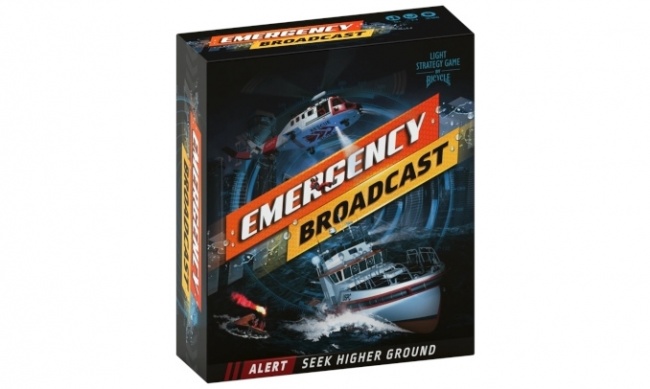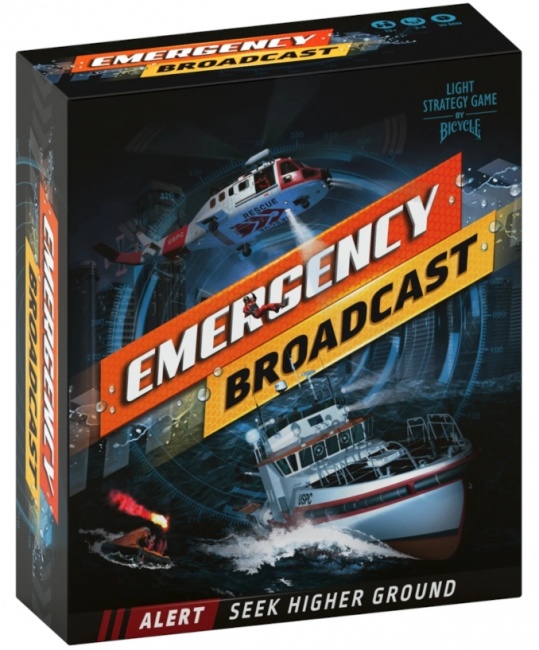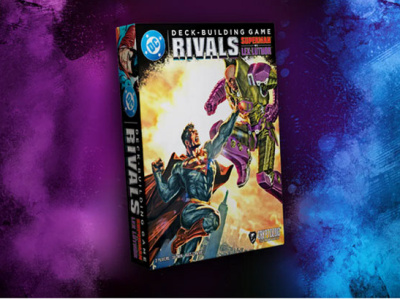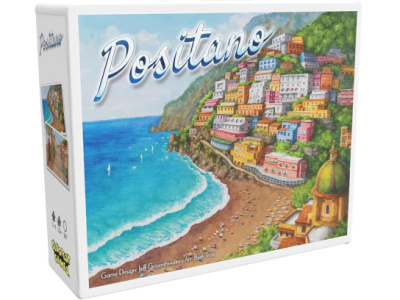Emergency Broadcast
Publisher: Bicycle
Release Date: August 1, 2021
MSRP: $24.99
Creators: N/A
Format: Boxed game with board, tiles & cards
Number of Players: 2-4
Playing Time: 30 Minutes
Age Rating: 13+
ICv2 Rating: 4 Stars out of 5
The venerable Bicycle game publisher has branched out from their standby of producing decks of cards, and in this case they've created a very interesting light game.
Bicycle has turned what would seem like an obvious co-op game setting into a competitive one, by seeing who can do the best job of rescuing folks from rising flood waters.
The game uses tiles in a refreshing way, as you stack them to reflect the rising water, which in turn reduces your available area to work with in the second and third parts of the game. Because of separate goal cards, the players are all playing with different things in mind, because one player might be looking to score for the largest group of first aid supplies, while another might want there to be a large number of separate troves of those same supplies. Life rafts, food, even batteries are part of the supply dumps, and their relative positions are how you score points. These relative positions can be for new moves, or in relation to things placed in previous rounds, depending on which goal cards you have. Most tiles are two squares in size, with most having different supplies on the two, but the game permits players to trade in a tile like that for a tile that covers only one square, but again with two different supplies. That sounds weird, but in fact sometimes that’s what you really want.
That seems almost too complex for a light game, but in fact everything is visually obvious, and the tactics of play are what a player needs to learn, from game to game. The rule book is simple, with just a few pages. The tiles you draw from a communal pile are held in front of you by a rack somewhat like you may remember from other games, like Scrabble or Mah Jongg. Score is kept on a dry erase board, which seems odd until you realize how many corrections you may need to make, the first time you try to add up scores. Not that the arithmetic is difficult, but in some cases you need to look carefully at the board to get the correct scoring numbers, and it’s easy to make mistakes until the way the board looks becomes familiar.
The game is sometimes cutthroat, in that what you want to achieve will frequently alter the scoring for the other players, usually to their detriment. Not so much "take that" as "my point scoring plan may step on yours". The short game length is surprisingly good for the game design, and works well. This is a filler game, but one that could also be used to start off an evening with new players.
The age range is largely to keep younger players from getting too frustrated with figuring out how to score points, but an intelligent younger child with experience playing games could probably handle this one.
--Nick Smith: Library Technician, Community Services, for the Pasadena Public Library in California.

ICv2 Stars: 4 (out of 5)
Posted by Nick Smith on September 2, 2021 @ 5:11 pm CT
MORE GAMES
'Rivals: Superman vs. Lex Luthor'
July 14, 2025
Cryptozoic Entertainment will release Rivals: Superman vs. Lex Luthor, a new standalone game for DC Deck-Building Game.
'Bomb Busters' Takes the Top Prize
July 14, 2025
The Spiel des Jahres jury has announced the winners of their 2025 board game awards.
MORE REVIEWS
ICv2 Stars: 4 (out of 5)
July 11, 2025
Here's a review of Positano, published by Slugfest Games.
ICv2 Stars: 3.5 (out of 5)
June 20, 2025
Check out the review of Disney Lorcana TCG: Illumineer's Quest - Palace Heist, from Ravensburger.









